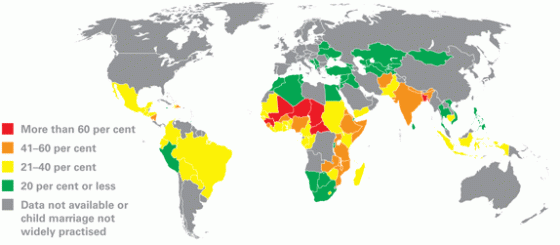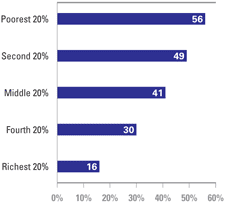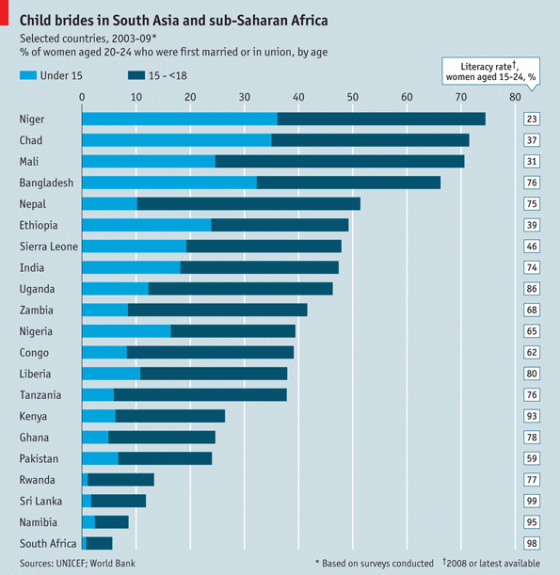In honor of International Day of the Girl, we’re publishing a post by Ruby, a volunteer at Plan International USA, on the topic of child marriage. You should also know that Ruby is a seventeen-year-old from Brooklyn, NY who doesn’t eat breakfast, but is pretty into lunch right now.
Find out how you can help keep girls walking to school…instead of walking down the aisle. Take action through Plan’s Because I am a Girl campaign and toolkits!
I’ve been to five weddings in my life, and they’ve all been beautiful, happy affairs between (with one exception) people much older than I. (The one exception was my six-year-old sister’s wedding to the television. That one was by far the happiest affair.). There aren’t many American teens who haven’t been to a wedding, and there are fewer still for whom the word “marriage” doesn’t trigger very specific images. For some, those images may be a huppah, an elephant, or a veil—I think of satin gowns, bridesmaids, vows, hors d’oeuvres, toasts from the best man, and other excruciatingly normal wedding things. But what comes to mind most clearly, and, I believe, universally, is the word maturity.
Marriage is a major life shift for young people, a significant passage from a glorified adolescent to (what looks like) an actual, responsible adult. Or it’s the union of two older, already-mature people who really want to start throwing couples dinner parties. Either or.
But of course, all of this talk is coming from an American who has lived nowhere but in America her entire life. You know what doesn’t come to mind when I think of weddings? Ten-year-old girls being married off to older men to save their families from starvation. But in many countries across the world, child marriage is a practice that’s all too prevalent.
Global Distribution of Early Marriage by Percentage of Girls
 source: http://filipspagnoli.wordpress.com/stats-on-human-rights/statistics-on-education/statistics-on-child-marriage/
source: http://filipspagnoli.wordpress.com/stats-on-human-rights/statistics-on-education/statistics-on-child-marriage/
In Bangladesh, Mali, Niger, Burkina Faso, Guinea, and the Central African Republic, more than 60 percent of girls are married before age 18. According to UNICEF’s estimates, over 64 million women currently aged 20-24 were child brides. Early marriage is a problem that disproportionately affects girls, and disproportionately affects poor girls—girls living in poor households are almost twice as likely to marry as children than those with greater economic means. In Mali, Mozambique, Bangladesh, and Niger are child brides over 75 percent of people live on less than $2 a day. Over half the girls in these same countries are child brides.
For families in poverty-stricken areas, early marriage is often a means of survival. Parents will encourage and even force their young daughters into matrimony in the hopes of benefiting the child financially, improving her social status, or relieving the family of an economic burden. “The main reason I married her off was to reduce the cost of my family,” said one Bangladeshi father who intended to give away his 16-year-old.
Percentage of women aged 20-24 who were married before age 18 , by wealth index (1987-2006)
Families will also choose early marriage in the hopes of reducing their daughters’ risk of contracting HIV/AIDS, since younger girls are more likely to be virgins when married. However, avoiding HIV infection through child marriage is a dangerous myth—child brides actually face a higher risk of infection when marrying an older man with more sexual experience. In Sub-Saharan Africa, girls aged 15-19 are 2 to 6 times more likely to contract HIV than boys the same age. Couple this with the dangers of pregnancy, which is the leading cause of death worldwide for girls aged 15-19, and early marriage becomes more of a death sentence than a safety net.
To make the issue even more complicated, child marriage is illegal nearly across the board. The Universal Declaration of Human Rights declares the right to “free and full” consent to marriage, which can’t be given when one of the parties isn’t legally an adult. The youngest a girl can marry is at age 15, which is the legal minimum in only five countries (the minimum is 18 nearly everywhere else). Yet girls are regularly wed as young as ten years old and become mothers by twelve, because their parents disregard or simply aren’t aware that child marriage is unlawful.
So how can we prevent these underground violations of both law and human rights? The simple answer is education. Make girls aware of their rights and their families aware of their daughters’ value. Studies show that the more education a girl receives, the less likely she is to become a child bride.
You can help by donating to or volunteering for organizations that deploy global and local efforts for girls education. A simple community-based program is enough to change the lives of hundreds of girls in an area who would otherwise be given away. Marriage doesn’t mean a satin gown and a line of bridesmaids for these girls. Why should we keep that definition for ourselves?


